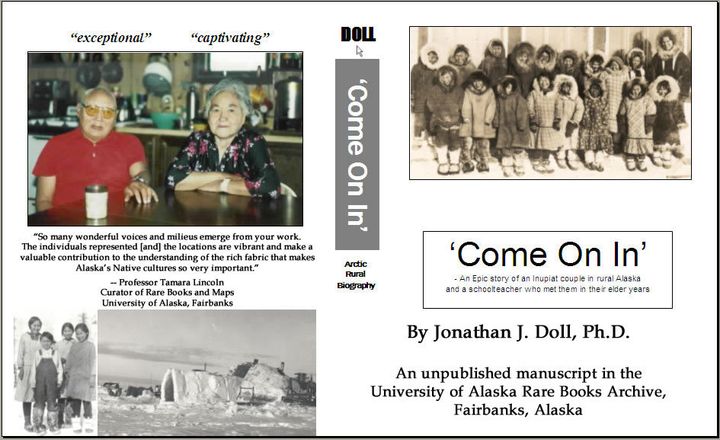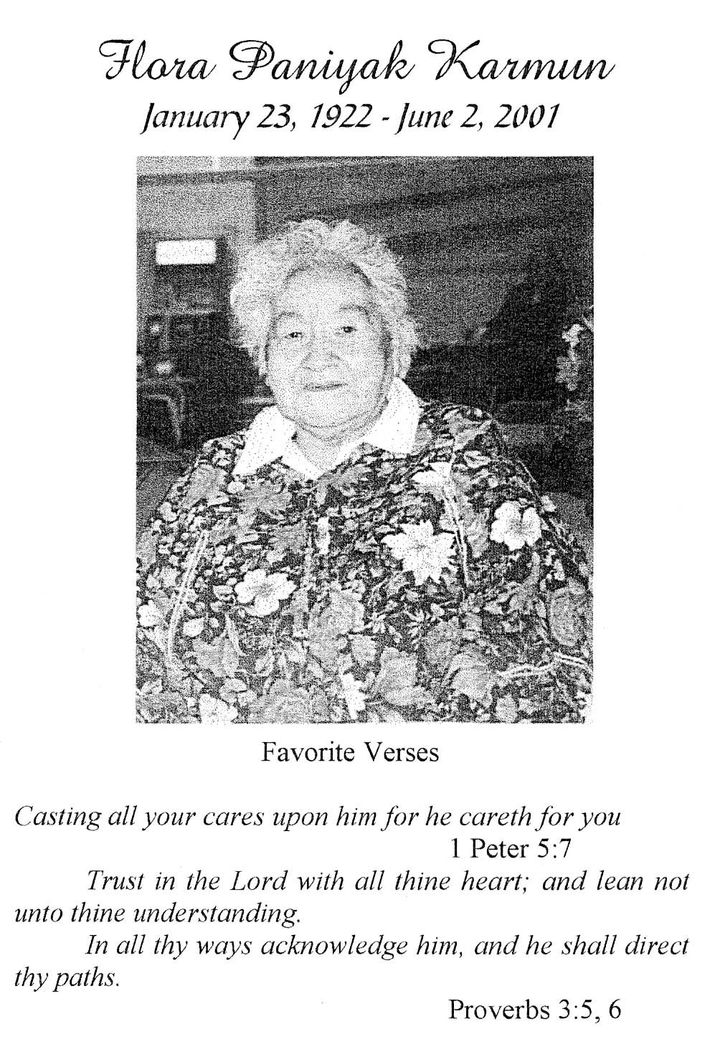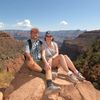___

This was a planned cover for a manuscript that was not published as of yet.
Part 3, The Conclusion
The following articles are written with thanks to the extended families of Flora Paniyak and Evans Karmun, an amazing couple in northwestern Alaska that I had the honor of knowing and sharing friendship with. As a result, the 380-page manuscript, ‘Come On In’ was compiled by the author in 2003.
In Part 1 of this series, I gave the Background for How I Met the Amazing Couple, Flora and Evans Karmun. In Part 2, I discussed the topic of “Changing the Heart of a Culture” and in Part 3, I share about “Changing the Heart of People when Errors were made.”
*-*-*-*-*-*-*-
It is difficult in the world of online and print news-media to fully convey a story from start to finish. So far in telling you about the amazing Alaska Native couple, Flora and Evans, I have captured the beginning of our friendship and shared a midpoint during a week where their friendship provided a needed boost for me as a teacher.
But you might rightfully be asking what the in-between times looked like and what is – as Paul Harvey used to say it – “the rest of the story.”
Well, let me start by saying that coming to the rural, arctic village of Deering as a teacher was a dream come true for me. As a child, I always wanted to go to Alaska or Northern Canada. And then driving to Alaska in the spring of 1998 cinched that dream. It also helped me have the courage to start setting newer and even bigger dreams.
I want to share about two significant times of setting new dreams – both of which are directly related to Flora and Evans and their impact on me. The first area was in getting my masters degree from the University of Alaska. The second was in using this excellent educational opportunity to complete a substantial amount of work in combing through and organizing a body of Alaska Native oral stories and traditions that were shared with me.
A Master’s Degree and How It Was Directly Connected to a Small Arctic Village
To tell the truth, I had started some of the Masters-level classes before I left for Deering because the state requires teachers to learn about Alaskan History and Cultural Education. But at the same time as taking these certification classes pre-dates meeting Flora and Evans, I think of it as preparation.
Another added plus came the summer that I left for Deering. Just about a month before, I took an Alaska Railroad/Alaska Airlines vacation to Fairbanks and Mt. McKinley. While on the famous Alaska Railroad and weaving between mountain peaks and impressive valleys, I had a thought. ‘Why not go see what the engine room looks like?’

Take a trip of a lifetime! www.alaskarailroad.com
So, I used some good old-fashioned boldness and charm. Then I walked to the front car where the engineers were and told them,
“Hey, I’m about to go and teach for a year in an Eskimo community. Could you show me the engine car of this train because it would give an amazing experience to share with my students?”
Sure enough, the engineer welcomed me into the engine car and showed me around. He described the 16 cylinders of the locomotive (as I recall) and how each was a little more than the size of a 5-gallon bucket! Wow, you could feel the horses of the train engine galloping as he was talking, and the thousands of pounds of thrust. And later, during that school year, I shared it all with my students to their amazement.
Over the course of a year of teaching in a rural village, many insights occurred. It actually was a daily routine, sometimes, to be in reflection. You see, when I would walk home from school in the evening, I would see wonderful displays of the northern lights right off the coast of Deering. This kept happening even through the chilly Deering winter. And it gave me time to think.
One day I remember pinching myself metaphorically because it dawned on me that as a child reading Jack London stories like Call of the Wild and White Fang, I had wanted to be in Alaska. And in high school, a career aptitude survey I took placed my life trajectory as being towards being a forest ranger (Please note, I didn’t agree with that estimation of my future goals!). But on the evening in Deering when I reflected on these past experiences, I thought to myself, ‘Wow, I could’ve been working in some remote area taking care of trees. But how much more valuable and important it is to be taking care of children, and in northern Alaska as was my childhood dream! Wow, wow, wow.’
But while I was teaching in Deering, it was the third year in my career. Still, I was still not all that polished and poised. There were days I struggled to make a lesson work or others that I had trouble keeping kids interested. Or still others where I let student behavior get the best of me. My principal pulled me aside one afternoon and said,
‘Look, it is entertainment for kids to get you off track and get you flustered. Think about it from their perspective. You are like Saturday Night Live for the students when you don’t have a handle on things!’
I tried to take his words to heart, but still lost my cool one day and said something insensitive in a class. I reacted to a situation rather than letting it pass and being more mature. That day I learned that we all make mistakes.
But Flora and Evans never waivered in their friendship – even if I did not feel like I was up to it at times. On some of the days I visited, one or the other of this vibrant couple might have been sick. But they regularly made the time. It was really amazing to me. Even if one stayed in the bedroom, the other made a point of spending time with me.
As I said in Part 2 of this series, Flora had a negative experience as a child when she was punished for speaking in her native language. She was upset about it when she shared the story, but not bitter. She was hurt, but truly had chosen to be made better by the experience. I’m not sure I could have been that strong. Also, I’m not condoning any of what happened through early Alaskan educators – since we are not living in their era – but I could tell from Flora that her lifetime mission and robust sense of character were not built on past hurts, but rather in future hope and promises. That is a legacy in the making, for certain!
A last thought about my master’s research project, ‘Come On In,’ was that it gave me an opportunity to talk about something that was very significant in the minds of academians who studied the Seward Peninsula, where Deering was located. You see, Archaeologists have long believed that the Bering Land Bridge was formed on that peninsula thousands of years ago and thus it was how Native American indigenous people were able to migrate to the ‘New World.’ That is a big topic, and I will save it for a future couple of articles. Suffice it to say that there may well be an error within the land bridge theory and its impact and academians have yet to find it.

Page 1 of a somber service. The passing of an amazing lady!
Seeing Writing as Way of Capturing a Legacy During The Long March of Time
As time marched on, Flora indeed passed away in 2001. Shortly thereafter, I flew to Deering for her funeral. It was remarkable and sad in that it marked the closing of an amazing chapter in Deering, Alaska.
Evans lived for 4 more years though without his sweetheart. In 2005, he also passed away just 9 days after his birthday that year. And once again, a chapter closed.
By that is not the best perspective to use in our lives. Each chapter leads to the next. And the next, and the next.
Also, when Flora passed away, I realized the enormity of it all and the great gift she had given me – along with Evans – while I was in Deering. As a result, I dedicated my Master’s research project to them – It was the story, Come On In — and included the transcription of all of the months of stories Evans and Flora shared with me. Of dogsleds and coal. Of railways and airplanes. Of gold and oil. Of new life and time passing. Even of Alaska Native traditions, oral history, and legends!
In 2005, when I learned of Evan’s passing away, I was also able to share copies of the manuscript with additional family members, as I had already shared it with village residents. It was a way of giving back to them. And saying thank you!
The Legacy
Flora and I both knew something together and we shared about it quite a bit during my visits. It was a sad, yet growing fact of life. It was something that would take time and maturity in people in order to change, and which sadly would outlast her years. She knew that. And so did I, though I was not 1/10th as wise as Flora and thus my insight on this was still growing too. ‘What is it?,’ you might rightfully ask.
This ‘fact of life’ that was hard to bear was two-fold. First, Alaska Natives around the state were losing the knowledge of their first languages. It was something that started with missionaries but continued in current times so that the deep knowledge of Inupiaq - and the many of other languages of other tribes in Alaska - were not being learned with the accuracy, stories, and preservation that had once been there.
So, kids were learning and knowing their native language in a more casual sense rather than as deeply as Flora would have hoped. There are pockets of places where this is not true (and language learning is robust and deep), but let’s be clear: 117 years ago (in 1900) Alaska Natives all spoke their native languages fluently and deeply knew their elders’ stories, history, traditions, and cultural identity. In the time since, western culture has placed barriers on this knowledge and English as a language has filled spaces that used to be fully and vibrantly non-English.
The second part of this ‘fact of life’ was even harder for Flora to bear. It was that no one besides me was beating a path to their door to hear their stories. To be fair, some of the children in the village did want to hear the stories of their elders, but no one was transcribing them. That hurt me and no doubt Flora even more. It hurt me for one simple reason: that each week with them was like watching a masterpiece on Broadway and then interviewing the cast! Truly, I could not get enough of their stories and of their coffee ;-) nonetheless!
But it also led to a responsibility I felt in my heart as left their house each week. With not much else to do in that tiny village up near the Arctic circle, I set about writing down everything they had told me on each visit. I would do this on the same day I visited so that the stories were fresh in my mind. As the year went on, the depth and breadth of the stories began increasing and becoming more interwoven at the same time. I recall one night that I wrote for hours and hours back at the school until my fingers ached from typing. I quit to go home and go to sleep only to remember several things that night which I had to “add” the next morning.
How, you might ask? The answer is that I was a former member of a church in Syracuse, New York that had a nice listserve. And as such, these fine folks prayed quite regularly for me. With those prayers, I felt compassion and courage to write, and write, and write. So, that was both how I recorded what Flora and Evans shared on each visit as well as how I kept in touch with these other folks halfway around the country.
Preserving a Legacy.
I’m left with those words hanging in the air as finish this third part of three articles. What is next? What needs to be next? One thing is an article series on the Educational Impact of the Bering Land Bridge Theory. Stay tuned.
My only complete answer, however, is to share my vision. I hope that the stories of Evans and Flora can become published to a degree that people can read about their lives and find challenge, hope, and a reassurance that cultures can co-exist, healing can occur from grievances in one’s lifetime, and hope can become real!
In closing, I want to share something from the 74th message I wrote in May of 2000 to that good old-fashioned listserve. It was an entry titled “Good-bye” and aptly finishes this discussion. Thanks for your time in reading all this. I hope it has been beneficial.
Saturday, May 20, 2000. Goodbye... So the end of my time here in the northwest corner of Alaska has come. It has been a good year. More good has come out of it than I could have expected. The harder things, like learning a new culture and being far away from my family really were just lessons I needed to learn. These things helped me appreciate the strength of families and of culture in Deering. This makes me ponder over what is coming next in life.
However, is there ever an end that does not have a new beginning after it? Is there ever a circle of rotation that does not have a center? Is there ever a time when we can say, "No purpose came out of that?" My answer is “no”, yet it means I still have a job to do in stating this lesson. It is to find that new beginning, that center from around which I have rotated, and anew that purpose I felt so assured of when I came. Nothing is wrong with finishing a task in life. Actually it is a joyful thing.
The birds are chirping outside though it is colder today; it is below freezing again. Laundry still graces many a clothesline here because the sun will yet appear from our overcast sky. The couple hundred seagulls on the east end of town seem quite flattered to fly in circles above the mouth of the river which has overflow water that they usually sit in when they tire of flying around. This sight of a flock in the sky is exhilarating. However, "all good things come to an..."
And with at, I would just add that the smiling faces of Flora and Evans always welcomed me. I encourage the reader to find older folks in their life who are similarly welcoming and learn from them. We all might have shortcomings in life, and we all make errors. It is an amazing thing, however, when a person surrenders to the opportunity of bringing goodness out of those things. The Good Book calls that finding and preserving ‘beauty for ashes.’
***
Dr. Jonathan Doll lived in Alaska from 1998 to 2004 and earned his Masters Degree from the University of Alaska in Anchorage. He credits the opening door to friendship and the wealth of knowledge he learned in the Karmun household to the sage wisdom of UAA Professor Stephen Haycox, who taught the class, Alaska History. Dr. Doll wrote the book Ending School Shootings (2015) after a 2013 school shooting in Centennial, Colorado and lives in Dubai with his wife Laura.
